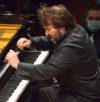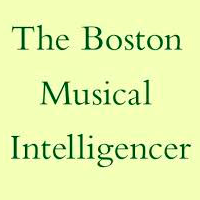Ode To A Grecian Turn

The Boston Philharmonic Youth Orchestra’s Symphony Hall concert on Friday night disclosed an ensemble fully armed artistically for its upcoming embarkation upon a tour of Greece. Of course, the armaments these “glowing and loving youth (BZ)” will bring to European listeners look to disarm anyone in the resident theaters. And as part of his apologia for playing Russian composers for what was going to have been a tour of Russia, Benjamin Zander allowed that the message will nevertheless give comfort to Ukrainian victims in the theater of war and reinforce the notion that the best Russians, like Tolstoy, Dostoevsky, and the great composers exemplify the Russian soul better than its current leaders. Furthermore, he pointed out Prokofiev’s Ukrainian birth and Tchaikovsky’s Ukrainian connections.
A year after Stalin died, Shostakovich penned his Festive Overture op. 96 on demand for the occasion of the 37th anniversary of the Bolshevik Revolution. In its seven-minute span it provides enough upbeat, nostalgic, triumphal, martial material and uncomplicated delights to prove the mettle for any touring orchestra. And it can serve at any festive occasion, such as the Olympics or the Nobel Prizes…and for any team or country for that matter. After the Korngoldish brass and timpani fanfare, the clarinets tunefully scampered in a melody taken up by the flutes and then building to a tutti. After many windups, balks, curves and fastballs, the tremendous final accelerando left us gasping. Proof of chops and mettle came early and often.
 Zander pridefully introduced Georgian Alexander Korsantia as one of today’s great pianists and a master in particular of Prokofiev’s Third Piano Concerto. “Think of it as Classical music with wrong notes,” he averred. After a quiet start with the clarinets, burbling strings induced the pianist to get right to work with rapid scalar passages. Korsantia gave no quarter in the fast and loud passages, but at other times contented himself to fade into the textures as another color instrument. Zander managed the extremes of dynamics, from many ps to turbulent, brutal, onrushing outbursts with many fs. Lyric refinement came as clarinetist Alexander Ehrlich-Herzog soared. Prokofiev never noodles, he keeps us on tenterhooks because no mood predominates. If he evokes someone else’s Pictures at an Exhibition at one moment, then comes a moment that could only have come from his pen—those glisses in the upper strings underlined by Chinese blocks.
Zander pridefully introduced Georgian Alexander Korsantia as one of today’s great pianists and a master in particular of Prokofiev’s Third Piano Concerto. “Think of it as Classical music with wrong notes,” he averred. After a quiet start with the clarinets, burbling strings induced the pianist to get right to work with rapid scalar passages. Korsantia gave no quarter in the fast and loud passages, but at other times contented himself to fade into the textures as another color instrument. Zander managed the extremes of dynamics, from many ps to turbulent, brutal, onrushing outbursts with many fs. Lyric refinement came as clarinetist Alexander Ehrlich-Herzog soared. Prokofiev never noodles, he keeps us on tenterhooks because no mood predominates. If he evokes someone else’s Pictures at an Exhibition at one moment, then comes a moment that could only have come from his pen—those glisses in the upper strings underlined by Chinese blocks.
The andante seemed to anticipate Alexander Nevsky, and other passing motifs could have come from the Classical Symphony or Peter and the Wolf. One of the chief pleasures of listening to Prokofiev comes in identifying materials he re-used so often in his extraordinary bag of tricks. Korsantia’s take on the dreamy but moving brief cadenza anticipated his encore. The manner in which Prokofiev fractalated melodic elements into so many shooting stars gave Zander great scope to zoom and pan among the sections and solos during these elaborations and cross-dressings. As truculent bombast alternated with quiet repose, he showed no fear of relaxation or overdrive. Other gripping moments included haunting horn calls over pianissimo strings before Korsantia’s, questing, anticipatory, improvisatory magic. Then it was off to the races again for no particular reason, except that it was the right time.
The Allegro ma non troppo third movement would whiten or bust the knuckles of most interpreters other than the composer, Korsantia and a few select others. Korsantia and Prokofiev could hardly be more different in stage manner, though. Prokofiev enjoyed fame for his imperturbable stage presence, whereas Korsantia undergoes contortions and gyrations which televise his inner thoughts. Some contracts for major orchestras, BTW, enjoin players from moving, while Zander encourages everyone to feel the music and sway, as they did most stunningly in Prokofiev Waltz. Korsantia (and the orchestra) dramatized with great sweep, yet the quiet rhapsodic segments where the lower strings accompanied Korsantia’s left-hand scales and right-hand block melodies proved telling. In larger moments the accents in the upper strings’ uniform bowing sounded in signal synchrony. The winds’ final questing interrogatory seemingly pondered, “Is this contingent ready for the European public and press,” to which the tutti and piano (with astonishing, scales, octaves, trills and Liszt-defying ornaments) concluded with an emphatically upbeat “Assuredly Yes!”
The audience and orchestra telegraphed their concurrence with foot-stomping and cheers. At the height of that frenzy Zander took pains to assert that “Every citizen of the free world must show solidarity with Ukraine and hold Putin as an enemy.” No one protested the sentiment.
To calm things down a bit Korsantia encored with a blissful, luminous account of Bolcom’s “Graceful Ghost Rag,” which put me in mind of Brahms’s FAF (Free but Happy). Amazingly, the piano had stayed in tune after the earlier pummeling. Bittersweet and never pushing too much swing, Korsantia channeled a consoling resignation. Would that he could “…teach the world to sing in [such] perfect harmony.”
Zander spoke of Tchaikovsky’s Symphony No. 6, Pathetique, as the “…saddest music in the world.” In his reduction of the first movement as depictions of 1. Anticipating Death, 2. Life and Love, 3. Aspiration, and then the 4th movement. Looking at Death Unflinchingly, he was positing a suicidal Tchaikovsky rather than one who got cholera from bad water. Experts continue to differ. (The handout confusingly showed the movements from the Tchaikovsky Fifth for some reason.)
In any case Zander delivered the old chestnut on its own terms, with no apparent attempt either to pander to romantic excess or strip accretions into something clean cut. Throughout, he conjured the deepest feelings of the moment while never become maudlin, even as he characterized the happiest riffs such as “smiling through gritted teeth” and interpreted the transition of the Waltz into a brazen march to the scaffold.
A forlorn and soulful bassoon proposal from Daniel McCarty led to an affirmation from the lower strings. The horn nodded in assent. After a pregnant Luftpause, the band repeated and re-clothed the first tune, then swelled. Upper strings added their embellishments as the winds continued to up the ante. Breathlessly we wondered, what will the master tell us? The brass briefly announced the coming of something, but again it’s a tease. The first hints of the big tune came in restrained understatement. Zander pulled luscious taffy as anticipation built. By eight minutes-in, tutti glory shone forth in life affirming splendor, constituting no anticipation of death to these ears. As the tune gets the full technicolor treatment, the clarinet swooned, the horns and strings knock at the door, and the race was on. Through all the transitions and handoffs Zander made something coherent of the sometimes-competing episodes. He masterfully kept a steady pulse underneath his tempo inflections and subtle rubatos. His attention to dynamics allowed even the ppppp low notes in the bass clarinet to carry. The timpanist Ritvik Yaparpalvi made a fine impression in his many exposed passages at every dynamic level, conveying more emotional variety than we usually get from the cans. Stunning pathos often erupted from the massive tutti’s but just as often subsided into solo meditations. We could hear Sugar Plum Fairies in unclouded but nevertheless consequential frolic. A frothy Mendelssohnian scherzo elicited smiles before vivace ruffles and flourishes from the piccolo cued the off-kilter waltz to turn menacing, martial loud, fast and triumphant. Applause ensued against the wishes of the conductor.
 The Finale: Adagio lamentoso hardly provides the expected ending for a big romantic symphony; it vaporizes in the minor mode like no other among Tchaikovsky’s six. It certainly fights life’s inevitably fatal outcome as obsessively compulsive warring themes contrast with insistent downward scales. The strings became a single-minded organism unafraid of shedding collective tears or outright sobbing. At times the wailing of the dead resounded in this Temple of Culture with pathetic affect, as the attempt to survive and arise became increasingly futile. Sadness overwhelms aspiration as the brass prophesize the futility of struggle. The timpani’s heartbeat fades like a dying swan as the cellos and basses utter the final muffled cry of pain. Tchaikovsky symphonic output and his life thus conclude morendo.
The Finale: Adagio lamentoso hardly provides the expected ending for a big romantic symphony; it vaporizes in the minor mode like no other among Tchaikovsky’s six. It certainly fights life’s inevitably fatal outcome as obsessively compulsive warring themes contrast with insistent downward scales. The strings became a single-minded organism unafraid of shedding collective tears or outright sobbing. At times the wailing of the dead resounded in this Temple of Culture with pathetic affect, as the attempt to survive and arise became increasingly futile. Sadness overwhelms aspiration as the brass prophesize the futility of struggle. The timpani’s heartbeat fades like a dying swan as the cellos and basses utter the final muffled cry of pain. Tchaikovsky symphonic output and his life thus conclude morendo.
Zander waited about 15 seconds to drop his baton. Then a single, if early, bravo started the warm salute to the players and their leader on this fadeout of a sad symphony and the bittersweet conclusions of their tours of duty for many of the young players. In best upper-crust British, stiff upper-lip manner, Zander sealed the deal for his departing players with a friendly and un-tragic traversal of “Nimrod” from the Enigma Variations.
And what has BPYO meant to these departing souls? Former player Hayley Miller Grainger, who recently joined the Dallas Symphony, tells us:
Benjamin Zander has created a Utopian orchestral landscape like no other. What a tremendous gift to have experienced a place where a diverse group of young musicians can come together to create some of the most compelling music I have ever experienced. BPYO celebrated each member’s unique talents and perspectives; we were allowed and encouraged to show up as our authentic selves, with all of our glorious imperfections. We learned together. The barriers were removed, and we could freely offer our best selves to the performances at hand. My appreciation for this space only deepens with time: I could not have realized what a beautiful and rare landscape this was. At the time, it was a safe haven. Today, it is encouragement and sustenance.
Click here to listen to Tchaikovsky’s Symphony no. 6.
Click here to listen to Elgar’s ‘Nimrod’.
 Lee Eiseman - The Boston Musical Intelligencer
Lee Eiseman - The Boston Musical Intelligencer